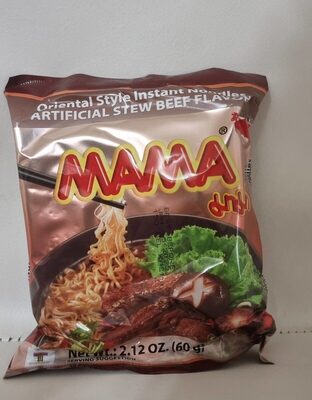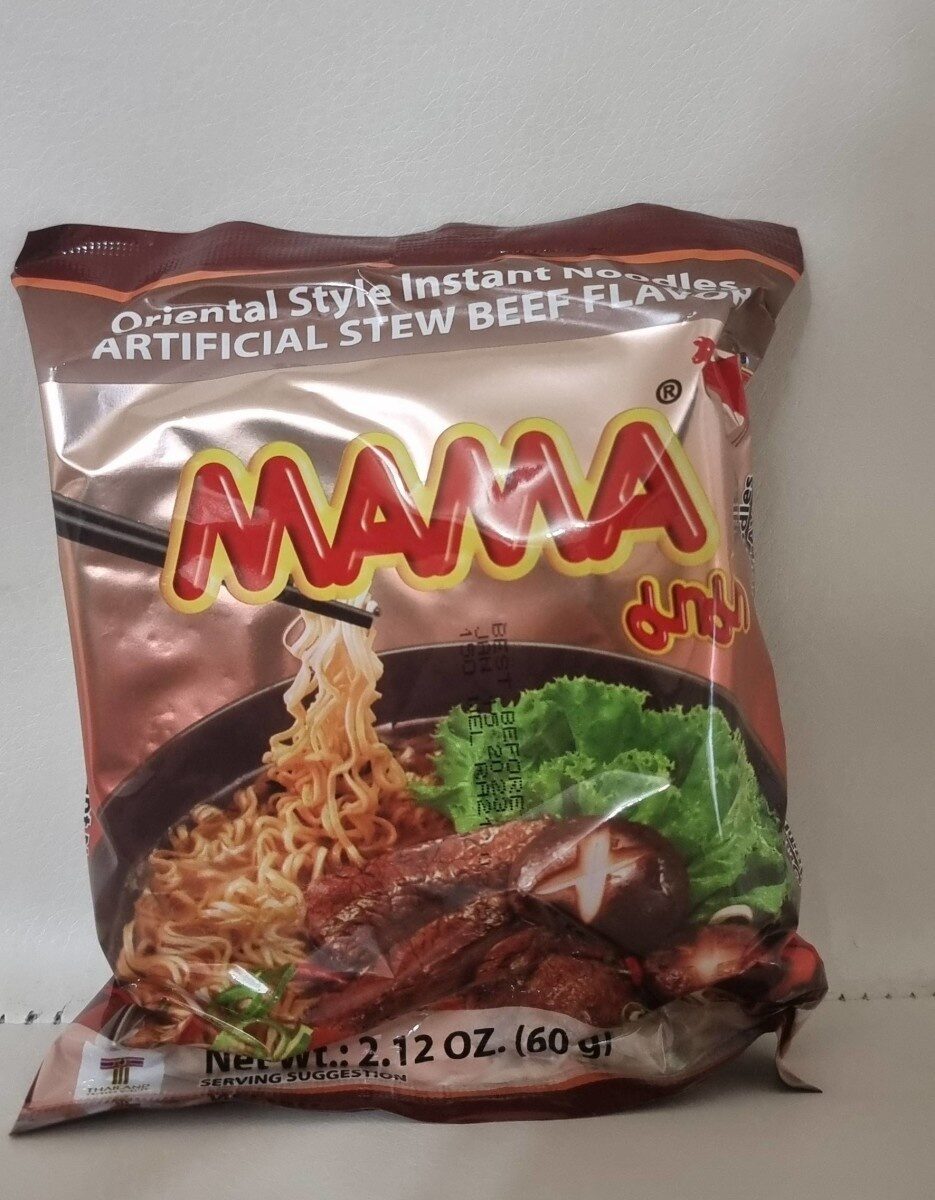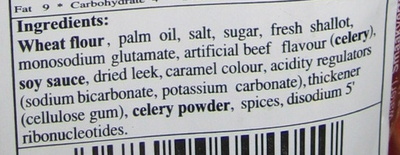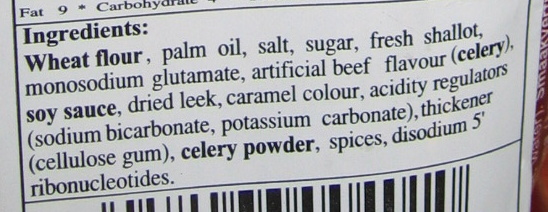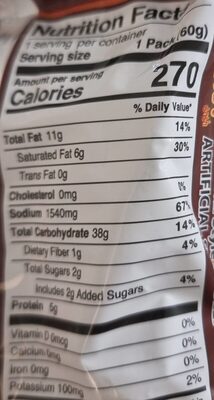Help us make food transparency the norm!
As a non-profit organization, we depend on your donations to continue informing consumers around the world about what they eat.
The food revolution starts with you!
Mama Ramen Beef Flavor - 60 g [Noodles 53 g + Seasoning 7 g]
Mama Ramen Beef Flavor - 60 g [Noodles 53 g + Seasoning 7 g]
This product page is not complete. You can help to complete it by editing it and adding more data from the photos we have, or by taking more photos using the app for Android or iPhone/iPad. Thank you!
×
Barcode: 0052066004010 (EAN / EAN-13) 052066004010 (UPC / UPC-A)
Common name: Ramen noodles beef
Quantity: 60 g [Noodles 53 g + Seasoning 7 g]
Packaging: Plastic, Wrapper, Metallized
Brands: Mama, Thai President Foods Public Company Limited, มาม่า
Categories: Plant-based foods and beverages, Plant-based foods, Cereals and potatoes, Cereals and their products, Dried products, Pastas, Dried products to be rehydrated, Noodles, Instant noodles
Labels, certifications, awards:
Thai quality label, Green Dot, Thailand Diversity & Refinement, For Export Only


Manufacturing or processing places: Thailand
Countries where sold: United States
Matching with your preferences
Health
Ingredients
-
18 ingredients
Wheat flour, palm oil, salt, sugar, fresh shallot, monosodium glutamate, atificial beef flavour (celery), soy sauce, dried leek, caramel colour, acidity regulators (sodium bicarbonate, potassium carbonate), thickener (cellulose gum), celery powder, spices, disodium 5' ribonucleotides.Allergens: Celery, Gluten, Soybeans
Food processing
-
Ultra processed foods
Elements that indicate the product is in the 4 - Ultra processed food and drink products group:
- Additive: E150c - Ammonia caramel
- Additive: E466 - Sodium carboxy methyl cellulose
- Additive: E621 - Monosodium glutamate
- Additive: E635 - Disodium 5'-ribonucleotide
- Ingredient: Thickener
Food products are classified into 4 groups according to their degree of processing:
- Unprocessed or minimally processed foods
- Processed culinary ingredients
- Processed foods
- Ultra processed foods
The determination of the group is based on the category of the product and on the ingredients it contains.
Additives
-
E466 - Sodium carboxy methyl cellulose
Carboxymethyl cellulose: Carboxymethyl cellulose -CMC- or cellulose gum or tylose powder is a cellulose derivative with carboxymethyl groups --CH2-COOH- bound to some of the hydroxyl groups of the glucopyranose monomers that make up the cellulose backbone. It is often used as its sodium salt, sodium carboxymethyl cellulose.Source: Wikipedia
-
E500 - Sodium carbonates
Sodium carbonates (E500) are compounds commonly used in food preparation as leavening agents, helping baked goods rise by releasing carbon dioxide when they interact with acids.
Often found in baking soda, they regulate the pH of food, preventing it from becoming too acidic or too alkaline. In the culinary world, sodium carbonates can also enhance the texture and structure of foods, such as noodles, by modifying the gluten network.
Generally recognized as safe, sodium carbonates are non-toxic when consumed in typical amounts found in food.
-
E500ii - Sodium hydrogen carbonate
Sodium hydrogen carbonate, also known as E500ii, is a food additive commonly used as a leavening agent.
When added to recipes, it releases carbon dioxide gas upon exposure to heat or acids, causing dough to rise and resulting in a light, fluffy texture in baked goods.
It is generally recognized as safe (GRAS) by regulatory authorities when used in appropriate quantities and poses no significant health risks when consumed in typical food applications.
-
E501 - Potassium carbonates
Potassium carbonate: Potassium carbonate -K2CO3- is a white salt, which is soluble in water -insoluble in ethanol- and forms a strongly alkaline solution. It can be made as the product of potassium hydroxide's absorbent reaction with carbon dioxide. It is deliquescent, often appearing a damp or wet solid. Potassium carbonate is used in the production of soap and glass.Source: Wikipedia
-
E501i - Potassium carbonate
Potassium carbonate: Potassium carbonate -K2CO3- is a white salt, which is soluble in water -insoluble in ethanol- and forms a strongly alkaline solution. It can be made as the product of potassium hydroxide's absorbent reaction with carbon dioxide. It is deliquescent, often appearing a damp or wet solid. Potassium carbonate is used in the production of soap and glass.Source: Wikipedia
-
E621 - Monosodium glutamate
Monosodium glutamate: Monosodium glutamate -MSG, also known as sodium glutamate- is the sodium salt of glutamic acid, one of the most abundant naturally occurring non-essential amino acids. Glutamic acid is found naturally in tomatoes, grapes, cheese, mushrooms and other foods.MSG is used in the food industry as a flavor enhancer with an umami taste that intensifies the meaty, savory flavor of food, as naturally occurring glutamate does in foods such as stews and meat soups. It was first prepared in 1908 by Japanese biochemist Kikunae Ikeda, who was trying to isolate and duplicate the savory taste of kombu, an edible seaweed used as a base for many Japanese soups. MSG as a flavor enhancer balances, blends, and rounds the perception of other tastes.The U.S. Food and Drug Administration has given MSG its generally recognized as safe -GRAS- designation. A popular belief is that large doses of MSG can cause headaches and other feelings of discomfort, known as "Chinese restaurant syndrome," but double-blind tests fail to find evidence of such a reaction. The European Union classifies it as a food additive permitted in certain foods and subject to quantitative limits. MSG has the HS code 29224220 and the E number E621.Source: Wikipedia
Ingredients analysis
-
Palm oil
Ingredients that contain palm oil: Palm oil
-
Vegan status unknown
Unrecognized ingredients: Atificial-beef-flavourSome ingredients could not be recognized.
We need your help!
You can help us recognize more ingredients and better analyze the list of ingredients for this product and others:
- Edit this product page to correct spelling mistakes in the ingredients list, and/or to remove ingredients in other languages and sentences that are not related to the ingredients.
- Add new entries, synonyms or translations to our multilingual lists of ingredients, ingredient processing methods, and labels.
If you would like to help, join the #ingredients channel on our Slack discussion space and/or learn about ingredients analysis on our wiki. Thank you!
-
Vegetarian status unknown
Unrecognized ingredients: Atificial-beef-flavourSome ingredients could not be recognized.
We need your help!
You can help us recognize more ingredients and better analyze the list of ingredients for this product and others:
- Edit this product page to correct spelling mistakes in the ingredients list, and/or to remove ingredients in other languages and sentences that are not related to the ingredients.
- Add new entries, synonyms or translations to our multilingual lists of ingredients, ingredient processing methods, and labels.
If you would like to help, join the #ingredients channel on our Slack discussion space and/or learn about ingredients analysis on our wiki. Thank you!
-
Details of the analysis of the ingredients
We need your help!
Some ingredients could not be recognized.
We need your help!
You can help us recognize more ingredients and better analyze the list of ingredients for this product and others:
- Edit this product page to correct spelling mistakes in the ingredients list, and/or to remove ingredients in other languages and sentences that are not related to the ingredients.
- Add new entries, synonyms or translations to our multilingual lists of ingredients, ingredient processing methods, and labels.
If you would like to help, join the #ingredients channel on our Slack discussion space and/or learn about ingredients analysis on our wiki. Thank you!
: _Wheat_ flour, palm oil, salt, sugar, shallot, monosodium glutamate, atificial beef flavour, _soy_ sauce, leek, caramel colour, acidity regulators (sodium bicarbonate, potassium carbonate), thickener (cellulose gum), _celery_ powder, spices, disodium 5' ribonucleotides- _Wheat_ flour -> en:wheat-flour - vegan: yes - vegetarian: yes - ciqual_proxy_food_code: 9410 - percent_min: 6.66666666666667 - percent_max: 100
- palm oil -> en:palm-oil - vegan: yes - vegetarian: yes - from_palm_oil: yes - ciqual_food_code: 16129 - percent_min: 0 - percent_max: 50
- salt -> en:salt - vegan: yes - vegetarian: yes - ciqual_food_code: 11058 - percent_min: 0 - percent_max: 6.4166666666668
- sugar -> en:sugar - vegan: yes - vegetarian: yes - ciqual_proxy_food_code: 31016 - percent_min: 0 - percent_max: 3.3333333333333
- shallot -> en:shallot - vegan: yes - vegetarian: yes - ciqual_food_code: 20097 - percent_min: 0 - percent_max: 3.3333333333333
- monosodium glutamate -> en:e621 - vegan: yes - vegetarian: yes - percent_min: 0 - percent_max: 3.3333333333333
- atificial beef flavour -> en:atificial-beef-flavour - percent_min: 0 - percent_max: 3.3333333333333
- _soy_ sauce -> en:soy-sauce - vegan: maybe - vegetarian: maybe - ciqual_food_code: 11104 - percent_min: 0 - percent_max: 3.3333333333333
- leek -> en:leek - vegan: yes - vegetarian: yes - ciqual_food_code: 20039 - percent_min: 0 - percent_max: 3.3333333333333
- caramel colour -> en:e150a - vegan: yes - vegetarian: yes - percent_min: 0 - percent_max: 3.3333333333333
- acidity regulators -> en:acidity-regulator - percent_min: 0 - percent_max: 3.3333333333333
- sodium bicarbonate -> en:e500ii - vegan: yes - vegetarian: yes - percent_min: 0 - percent_max: 3.3333333333333
- potassium carbonate -> en:e501i - vegan: yes - vegetarian: yes - percent_min: 0 - percent_max: 1.66666666666665
- thickener -> en:thickener - percent_min: 0 - percent_max: 3.3333333333333
- cellulose gum -> en:e466 - vegan: yes - vegetarian: yes - percent_min: 0 - percent_max: 3.3333333333333
- _celery_ powder -> en:celery-powder - vegan: yes - vegetarian: yes - ciqual_proxy_food_code: 20055 - percent_min: 0 - percent_max: 3.3333333333333
- spices -> en:spice - vegan: yes - vegetarian: yes - percent_min: 0 - percent_max: 3.3333333333333
- disodium 5' ribonucleotides -> en:e635 - vegan: maybe - vegetarian: maybe - percent_min: 0 - percent_max: 3.3333333333333
-
Nutrition facts
Nutrition facts As sold
for 100 g / 100 mlAs sold
per serving (60 g)Compared to: Instant noodles Energy 1,883 kj
(450 kcal)1,130 kj
(270 kcal)+49% Fat 18.333 g 11 g +64% Saturated fat 10 g 6 g +102% Trans fat 0 g 0 g -100% Cholesterol 0 mg 0 mg -100% Carbohydrates 63.333 g 38 g +51% Sugars 3.333 g 2 g +31% Fiber 1.667 g 1 g -19% Proteins 8.333 g 5 g +28% Salt 6.417 g 3.85 g +143% Vitamin A 0 µg (0 % DV) 0 µg -100% Vitamin C (ascorbic acid) 0 mg (0 % DV) 0 mg -100% Calcium 0 mg (0 % DV) 0 mg -100% Iron 0 mg (0 % DV) 0 mg -100% Fruits‚ vegetables‚ nuts and rapeseed‚ walnut and olive oils (estimate from ingredients list analysis) 5 % 5 %
Environment
-
Eco-Score C - Moderate environmental impact
⚠ ️Select a country in order to include the full impact of transportation.The Eco-Score is an experimental score that summarizes the environmental impacts of food products.→ The Eco-Score was initially developped for France and it is being extended to other European countries. The Eco-Score formula is subject to change as it is regularly improved to make it more precise and better suited to each country.Life cycle analysis
-
Average impact of products of the same category: A (Score: 82/100)
Category: Asian noodles, flavoured, dehydrated
Category: Asian noodles, flavoured, dehydrated
- PEF environmental score: 0.26 (the lower the score, the lower the impact)
- including impact on climate change: 1.67 kg CO2 eq/kg of product
Stage Impact Agriculture
65.5 %Processing
20.6 %Packaging
8.7 %Transportation
3.5 %Distribution
1.8 %Consumption
0.0 %
Bonuses and maluses
-
Missing origins of ingredients information
Malus: -5
⚠ ️ The origins of the ingredients of this product are not indicated.
If they are indicated on the packaging, you can modify the product sheet and add them.
If you are the manufacturer of this product, you can send us the information with our free platform for producers.
-
Ingredients that threatens species
Malus: -10
Contains palm oil
Tropical forests in Asia, Africa and Latin America are destroyed to create and expand oil palm tree plantations. The deforestation contributes to climate change, and it endangers species such as the orangutan, the pigmy elephant and the Sumatran rhino.
-
Packaging with a medium impact
Malus: -10
Shape Material Recycling Impact Wrapper Plastic High ⚠ ️ The information about the packaging of this product is not sufficiently precise (exact shapes and materials of all components of the packaging).⚠ ️ For a more precise calculation of the Eco-Score, you can modify the product page and add them.
If you are the manufacturer of this product, you can send us the information with our free platform for producers.
Eco-Score for this product
-
Impact for this product: C (Score: 57/100)
Product: Mama Ramen Beef Flavor - 60 g [Noodles 53 g + Seasoning 7 g]
Life cycle analysis score: 82
Sum of bonuses and maluses: -25
Final score: 57/100
-
Carbon footprint
-
Equal to driving 0.9 km in a petrol car
167 g CO² per 100g of product
The carbon emission figure comes from ADEME's Agribalyse database, for the category: Asian noodles, flavoured, dehydrated (Source: ADEME Agribalyse Database)
Stage Impact Agriculture
61.0 %Processing
14.9 %Packaging
16.3 %Transportation
6.8 %Distribution
1.0 %Consumption
0.0 %
Packaging
-
Packaging with a medium impact
-
Packaging parts
Wrapper (Plastic)
-
Packaging materials
Material % Packaging weight Packaging weight per 100 g of product Plastic
-
Transportation
-
Origins of ingredients
Missing origins of ingredients information
⚠ ️ The origins of the ingredients of this product are not indicated.
If they are indicated on the packaging, you can modify the product sheet and add them.
If you are the manufacturer of this product, you can send us the information with our free platform for producers.Add the origins of ingredients for this product Add the origins of ingredients for this product
Threatened species
-
Contains palm oil
Drives deforestation and threatens species such as the orangutan
Tropical forests in Asia, Africa and Latin America are destroyed to create and expand oil palm tree plantations. The deforestation contributes to climate change, and it endangers species such as the orangutan, the pigmy elephant and the Sumatran rhino.
Report a problem
-
Incomplete or incorrect information?
Category, labels, ingredients, allergens, nutritional information, photos etc.
If the information does not match the information on the packaging, please complete or correct it. Open Food Facts is a collaborative database, and every contribution is useful for all.
Data sources
Product added on by kp757
Last edit of product page on by ecoscore-impact-estimator.
Product page also edited by kiliweb, packbot, upcbot, yuka.sY2b0xO6T85zoF3NwEKvln5-D_XUrirCKh_RoHWk9OvTB4zTQe5Mx5L5bqo.
